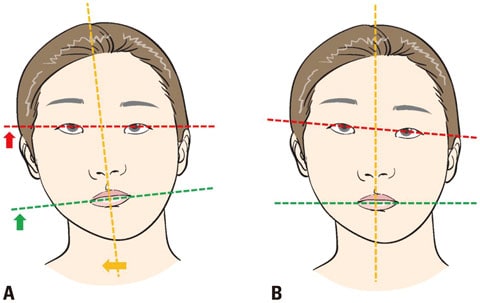Facial asymmetry in children and adults can often be traced back to imbalances in oral function and skeletal growth—especially when the tongue isn’t positioned correctly on the palate, or when tethered oral tissues (like tongue, lip, or buccal ties) pull unevenly on facial muscles and bones. At TMJ Sleep and Breathe Center, we use a holistic approach to the treatment of facial asymmetries that includes neutral bite plane appliances, frenectomy procedures, and myofunctional therapy to help the face grow more symmetrically from the inside out.

How Facial Asymmetries Develop
Facial asymmetry doesn’t usually result from trauma or genetics alone. It frequently stems from functional imbalances during growth, including:
1. Tongue Posture and Jaw Development
When the tongue does not rest on the roof of the mouth (the palate), it loses its natural role as an internal support for the upper jaw. Without that gentle, upward pressure:
- The maxilla (upper jaw) can collapse downward
- One side of the jaw may drop lower than the other
- The entire midface can shift off-center
- Facial elongation and asymmetry become more pronounced
2. Tethered Oral Tissues (Ties)
Tight tongue, lip, or buccal ties restrict movement and create asymmetric tension. When these restrictions are tighter on one side than the other:
- Facial growth can be pulled unevenly
- The jaw may grow at an angle
- Cheeks and eye areas may appear imbalanced
3. Mouth Breathing and Muscle Imbalance
Chronic mouth breathing—often resulting from nasal obstruction, ties, or improper tongue posture—disrupts normal facial muscle tone and growth direction. This can:
- Cause one side of the face to be more active than the other
- Lead to muscular asymmetry and slanted growth patterns
The Role of the Bite Plane in Facial Balance
Bite plane appliances are used in many of our orthopedic and orthodontic devices to support the jaw in a neutral, balanced position. This “neutral bite plane” encourages:
- Relaxation of head, neck, and jaw muscles
- Equalized pressure across the dental arches
- A more centered lower jaw position
- Improved symmetry in bite force and muscular tone
By reducing the influence of an unbalanced bite, the bite plane gives the bones and soft tissues a chance to grow and settle more symmetrically.
Many of our appliances—including the Homeoblock, Schwarz, DNA appliance, and even our MASPE expanders can incorporate bite planes designed to encourage symmetry during growth.
Pairing Bite Plane Therapy with Tie Releases and Myofunctional Work
The best results in correcting facial asymmetry come from addressing both the structure and function of the oral environment. At TMJ Sleep and Breathe Center, we often pair bite plane therapy with:
1. Laser Release of Lip, Buccal, and Tongue Ties
When ties are released—especially if one side is more restricted than the other—we often see a dramatic shift toward more balanced growth and posture. We use the LightScalpel CO2 laser for precise, low-trauma frenectomies. Benefits include:
- Improved tongue range of motion
- Elimination of asymmetrical tension from one-sided restrictions
- Better oral rest posture
2. Myofunctional Therapy
Myofunctional therapy retrains the oral and facial muscles to:
- Support a closed mouth posture
- Maintain nasal breathing
- Keep the tongue on the roof of the mouth
- Swallow and speak correctly
When combined with appliance therapy and tie release, myofunctional therapy reinforces the newly balanced environment and helps guide symmetrical growth.
Why Early Intervention Matters
Children’s faces grow rapidly—and the earlier we intervene, the more we can influence bone remodeling and symmetry. That said, adults can also benefit from this integrated approach. Facial asymmetries in adults may soften, and muscular imbalances can often be retrained and improved over time.
Signs your child (or you) may benefit from this treatment approach include:
- A noticeable midline shift
- Asymmetrical smile or jaw movements
- Chronic teeth clenching or grinding
- Mouth breathing
- Narrow or high-arched palate
- Slanted eye or cheek level in photos
Our Holistic Approach to Facial Balance
At TMJ Sleep and Breathe Center, we don’t simply treat the teeth—we work with the entire craniofacial system to improve form, function, and long-term wellness.
Our protocol for addressing facial asymmetry includes:
- Comprehensive airway and skeletal evaluation (including CBCT imaging)
- Custom appliance therapy with a neutral bite plane
- Slow, biological palatal expansion (MASPE)
- Targeted release of oral ties using CO2 laser
- Myofunctional therapy from trained providers
- Ongoing monitoring and functional integration
Schedule a Consultation
If you or your child are showing signs of facial asymmetry or imbalance, it’s important to address the root cause—not just the appearance. Our integrative approach can help restore balance, improve breathing, and support healthier facial development.
Contact us today at TMJ Sleep and Breathe Center to schedule a consultation and learn how we can help you achieve more symmetrical, functional, and confident growth.
 703-712-1053
703-712-1053 